| کد مقاله | کد نشریه | سال انتشار | مقاله انگلیسی | نسخه تمام متن |
|---|---|---|---|---|
| 5857021 | 1131990 | 2014 | 15 صفحه PDF | دانلود رایگان |

- An 8-week study in human volunteers examined the effects of EPG vs. margarine.
- Fat-soluble nutrients were unaffected, except for lower β-carotene and phylloquinone.
- PIVKA-II increased, and 25-OH D3 increased but to a lesser extent than margarine.
- No effects were seen in vital signs, clinical pathology, PTH, PT, PTT, etc.
- GI adverse events were reported more frequently with 25 and 40Â g EPG/day.
This double-blind, randomized, controlled study assessed the effect of esterified propoxylated glycerol (EPG) on fat-soluble vitamins and select nutrients in human subjects. For 8 weeks, 139 healthy volunteers consumed a core diet providing adequate caloric and nutrient intakes. The diet included items (spread, muffins, cookies, and biscuits) providing EPG (10, 25, and 40 g/day) vs. margarine alone (control). EPG did not significantly affect circulating retinol, α-tocopherol, or 25-OH D2, but circulating β-carotene and phylloquinone were lower in the EPG groups, and PIVKA-II levels were higher; 25-OH D3 increased but to a lesser extent than the control. The effect might be related to EPG acting as a lipid “sink” during gastrointestinal transit. No effects were seen in secondary endpoint measures (physical exam, clinical pathology, serum folate, RBC folate, vitamin B12, zinc, iron, calcium, phosphorus, osteocalcin, RBP, intact PTH, PT, PTT, cholesterol, HDL-C, LDL-C, triglycerides). Gastrointestinal adverse events (gas with discharge; diarrhea; oily spotting; oily evacuation; oily stool; liquid stool; soft stool) were reported more frequently by subjects receiving 25 or 40 g/day of EPG. In general, the incidence and duration of these symptoms correlated directly with EPG dietary concentration. The results suggest 10 g/day of EPG was reasonably well tolerated.
Journal: Regulatory Toxicology and Pharmacology - Volume 70, Supplement 2, 31 December 2014, Pages S143-S157